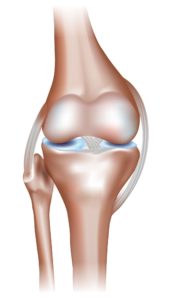17 July 2020
17 July 2020
Physical activity is important for our musculoskeletal system, to be precise - for the muscular system suspended in the skeletal system, including one of the largest of our joints: the knee joint! What do knees like and dislike? Why is it worth taking care of them? What kinds of activities are recommended?
The knee is an important element of the osteoarticular system. Problems with the knee joint make us unable to function normally. Pain makes it impossible to do static and kinetic exercises, it also changes the mechanics of the gait, which negatively affects the spine and other joints of the lower limb. Even if the discomforts pass over time, there may be permanent changes to other joints requiring treatment.
There are many reasons for problems with knee joints. However, those who think that they only affect people who have had traffic accidents and lovers of sports activities are wrong. On the contrary!
Our body loves to move, and the knee - because of its structure - is even dependent on it. Therefore, more and more young people visit the orthopedist, and their problems with the knees are not the result of sports injuries, but ... a sedentary lifestyle – says Mateusz Janik MD Ort, specialist in orthopedics and traumatology of the musculoskeletal system.
Physical activity is important to our knees for a number of reasons:

First of all, our knees do not like sedentary lifestyle, excess weight, which overloads them, and smoking, which reduces supply of oxygen to the body, including articular cartilage, negatively affecting its regeneration. The knee joint dislikes static overloads, such as standing work, and injuries.
Apart from damage to the knee joint in situations such as traffic accidents, overweight or standing work, injuries can also occur during sports, including amateur sports. Orthopedists emphasize that relatively most knee injuries are the result of playing football - torsion injuries are the most common. But the cause of a knee injury can also be other team games: volleyball, basketball and handball (due to jumps) and running. A large number of knee injuries occur when playing on artificial, hard surfaces. In such cases, a locked torsion injury occurs.
Question - how to exercise so as not to harm oneself?
APhysical activity is essential for our body, but we must practice recreational sports wisely. The type of discipline should be chosen according to the age, and the loads should be adjusted to our current abilities (efficiency). The best recreation is exercises performed every other day: this allows the muscle tissue to regenerate (as opposed to everyday physical exertion) – explains Piotr Wiśniewski MD, PhD, specialist in orthopedics and traumatology of the musculoskeletal system from the Carolina Medical Center in Gdańsk.
Any activity is good, as long as there are no contraindications for doing it. After the age of 40, we should ride a bike, swim (backstroke or crawl - the frog style is not recommended), do Nordic walking or do daily physical training. Forcing walks, jogging, team games, crossfit activities and step aerobics should not be dominant forms of exercise. But if we like walking or running a lot - do not give them up, but limit them in favor of other activities. A good solution for women - in all age groups - is, for example, stretching aerobics.
As a result of various types of injuries of the knee joint, the most common injuries concern the articular cartilage, menisci and the ligamentous system. Intra-articular fractures are less common. Damage to the articular cartilage is more likely to affect the elderly, and younger people - meniscal and ligamentous lesions..
Nowadays, people - including young people - suffer from cartilage injuries resulting from… lack of any physical activity. Knee articular cartilage reconstruction surgeries in 20-year-olds are unfortunately not unique today – said Marcin Mikulicz MD Ort, specialist in orthopedics and traumatology of the musculoskeletal system from the Carolina Medical Center in Gdańsk.
Another issue is the degeneration of the knee joint, i.e. gonarthrosis. It is a process that causes the destruction of articular cartilage and may occur not only in older but also younger patients. Degenerations may also be associated with distortions, when the articular cartilage is damaged by bone damage and deformation. We must be aware that the degenerative changes in the knee develop quickly and ... they will not repair themselves. The longer we wait, the more complicated the treatment may be!
The choice of treatment method depends on the type and extent of damage, the patient's age and expectations. The type and extent of damage is determined by imaging diagnostics. If we report to a specialist quickly enough, our treatment will probably be limited to rehabilitation, which is often a sufficient method of conservative treatment and saves us from surgical intervention.
However, if surgery is unavoidable, we always try to find the best solution for the patient. We place a premium on minimally invasive treatment. An example is arthroscopy of the knee joint. Through a small incision in the skin around the knee joint, we insert the camera and optical fiber as to see the joint from inside. Using this kind of minimally invasive surgical techniques, we can perform ligament reconstructions, reconstruction of damaged articular cartilage, or suture menisci. Arthroscopic techniques enable low-traumatized surgical treatment, quick to perform and enabling efficient rehabilitation and, consequently, faster recovery of the patient – adds doctor Wiśniewski.
If degenerative changes in the knee joint are advanced, the patient is eligible for knee replacement. It is more invasive treatment, it involves removal of damaged articular surfaces and replacing them with metal surfaces (prostheses).